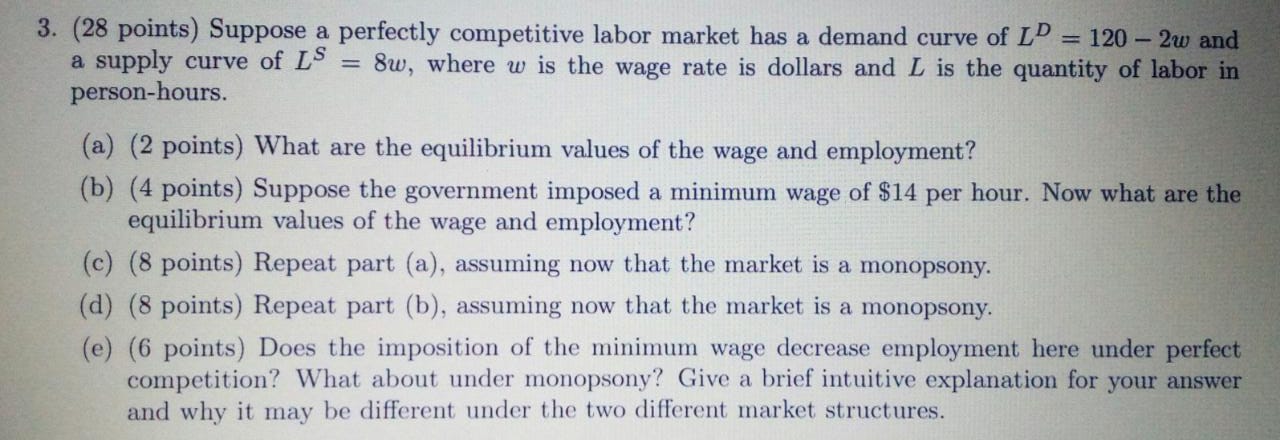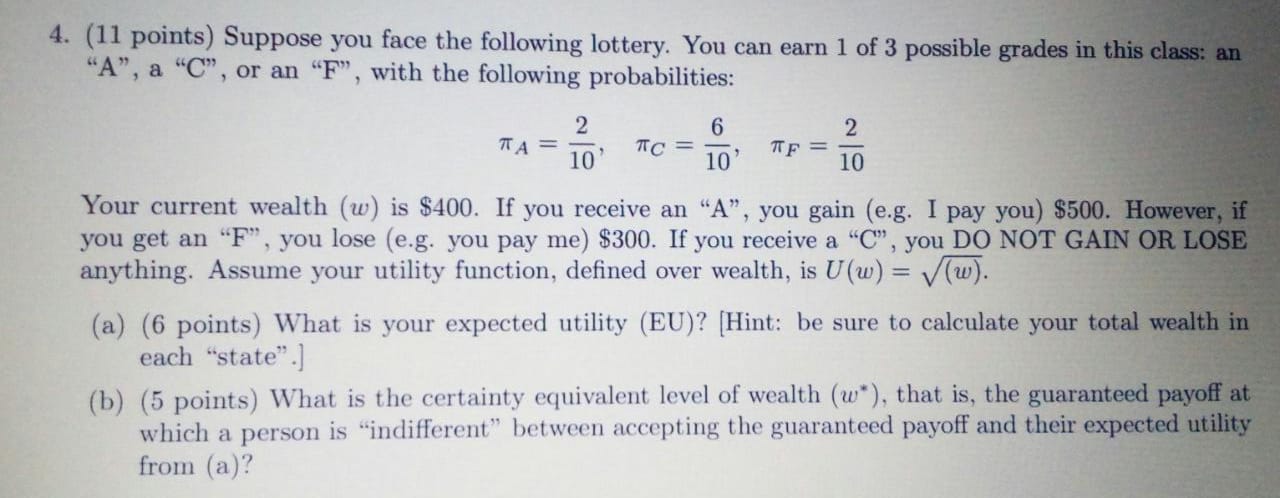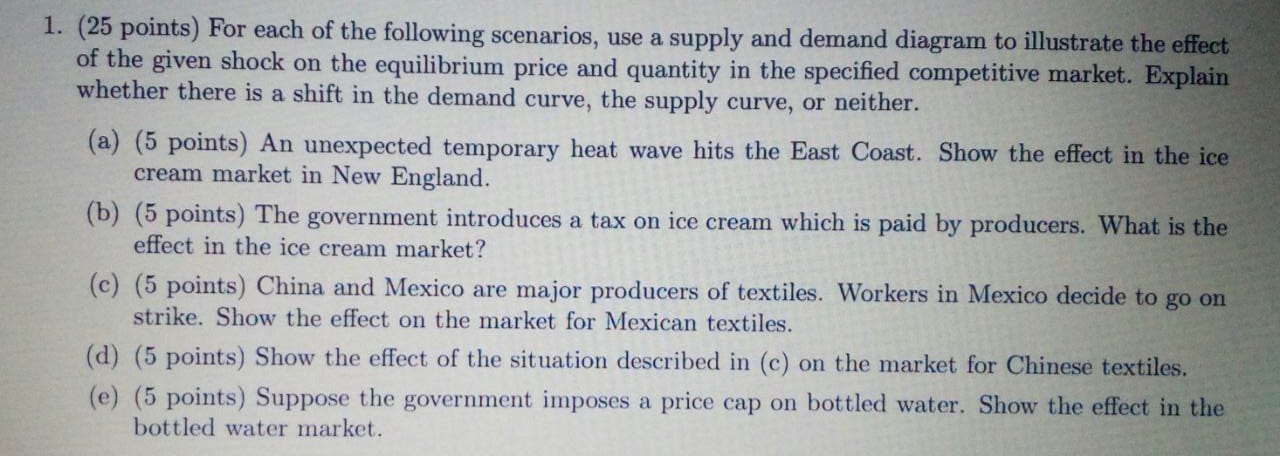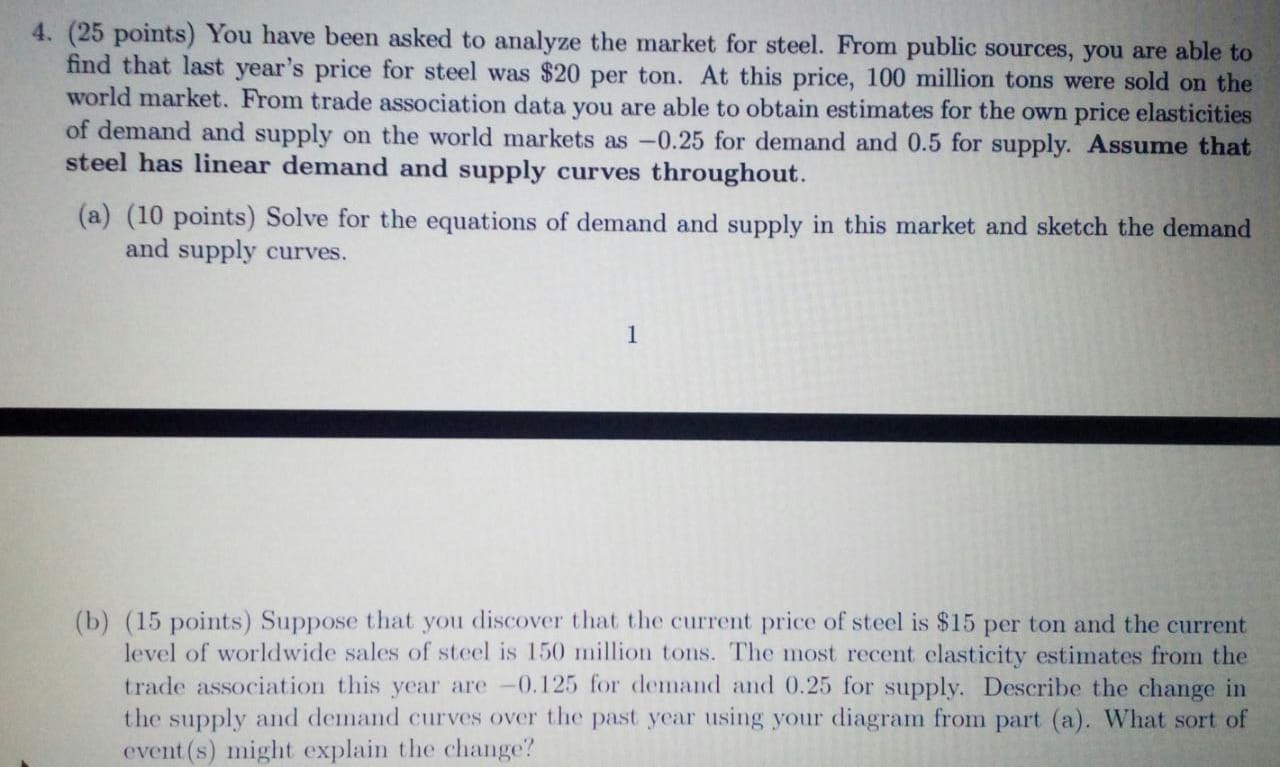please answer in detail. thank you.
1. (36 points) Two firms, A and B, are competing in the production of a homogenous good. The good's marginal cost for both firms is equal, MC = $25. Assuming linear reaction functions, describe what would happen to output and price in each of the following situations if the firms are in (i) collusive equilibrium, (ii) Cournot equilibrium, (iii) Bertrand equilibrium. (a) (4 points for each of (i)-(iii)) The demand curve shifts to the left. (b) (4 points for each of (i)-(iii)) Because it invents a new and improved machine, the marginal cost at firm B decreases to $20. (c) (4 points for each of (i)-(iii)) Costs in the entire industry increase due to an increase in wages.3. (28 points) Suppose a perfectly competitive labor market has a demand curve of LP = 120 - 2w and a supply curve of L' = 8w, where w is the wage rate is dollars and L is the quantity of labor in person-hours. (a) (2 points) What are the equilibrium values of the wage and employment? (b) (4 points) Suppose the government imposed a minimum wage of $14 per hour. Now what are the equilibrium values of the wage and employment? (c) (8 points) Repeat part (a), assuming now that the market is a monopsony. (d) (8 points) Repeat part (b), assuming now that the market is a monopsony. (e) (6 points) Does the imposition of the minimum wage decrease employment here under perfect competition? What about under monopsony? Give a brief intuitive explanation for your answer and why it may be different under the two different market structures.4. (11 points) Suppose you face the following lottery. You can earn 1 of 3 possible grades in this class: an "A", a "C", or an "F", with the following probabilities: TA= 2 6 2 10 TO = 10 10 Your current wealth (w) is $400. If you receive an "A", you gain (e.g. I pay you) $500. However, if you get an "F", you lose (e.g. you pay me) $300. If you receive a "C", you DO NOT GAIN OR LOSE anything. Assume your utility function, defined over wealth, is U(w) = (w). (a) (6 points) What is your expected utility (EU)? [Hint: be sure to calculate your total wealth in each "state". ] (b) (5 points) What is the certainty equivalent level of wealth (w*), that is, the guaranteed payoff at which a person is "indifferent" between accepting the guaranteed payoff and their expected utility from (a)?1. (25 points) For each of the following scenarios, use a supply and demand diagram to illustrate the effect of the given shock on the equilibrium price and quantity in the specified competitive market. Explain whether there is a shift in the demand curve, the supply curve, or neither. (a) (5 points) An unexpected temporary heat wave hits the East Coast. Show the effect in the ice cream market in New England. (b) (5 points) The government introduces a tax on ice cream which is paid by producers. What is the effect in the ice cream market? (c) (5 points) China and Mexico are major producers of textiles. Workers in Mexico decide to go on strike. Show the effect on the market for Mexican textiles. (d) (5 points) Show the effect of the situation described in (c) on the market for Chinese textiles. (e) (5 points) Suppose the government imposes a price cap on bottled water. Show the effect in the bottled water market.2. (20 points) For each of the following pairs of goods, identify which one you would expect to have more own-price elastic demand. Please explain your reasoning. (a) (5 points) Computers (generally) vs. Apple MacBook Pro laptops. (b) (5 points) Stereo headphones (generally) vs. hearing aids. For each of the following goods, identify whether you would expect demand to be more (own-price) elastic in the short run or the long run. As above, please briefly explain your reasoning. (c) (5 points) Retail gasoline in the suburbs of Chicago. (d) (5 points) Air conditioning units in Miami Beach, Florida.3. (30 points) Consider the market for apple juice. In this market, the supply curve is given by Qs = 10PJ - 5PA and the demand curve is given by QD = 100 - 15PJ + 10Pr, where J denotes apple juice, A denotes apples, and T denotes tea. (a) (7 points) Assume that PA is fixed at $1 and Pr = 5. Calculate the equilibrium price and quantity in the apple juice market. (b) (7 points) Suppose that a poor harvest season raises the price of apples to PA = 2. Find the new equilibrium price and quantity of apple juice. Draw a graph to illustrate your answer. (c) (8 points) Suppose PA = 1 but the price of tea drops to Pr = 3. Find the new equilibrium price and quantity of apple juice. (d) (8 points) Suppose PA = 1, Pr = 5, and there is a price ceiling on apple juice of P} = 5. What is the excess demand for apple juice as a result? Draw a graph to illustrate your answer.4. (25 points) You have been asked to analyze the market for steel. From public sources, you are able to find that last year's price for steel was $20 per ton. At this price, 100 million tons were sold on the world market. From trade association data you are able to obtain estimates for the own price elasticities of demand and supply on the world markets as -0.25 for demand and 0.5 for supply. Assume that steel has linear demand and supply curves throughout. (a) (10 points) Solve for the equations of demand and supply in this market and sketch the demand and supply curves. (b) (15 points) Suppose that you discover that the current price of steel is $15 per ton and the current level of worldwide sales of steel is 150 million tons. The most recent elasticity estimates from the trade association this year are -0.125 for demand and 0.25 for supply. Describe the change in the supply and demand curves over the past year using your diagram from part (a). What sort of event (s) might explain the change













